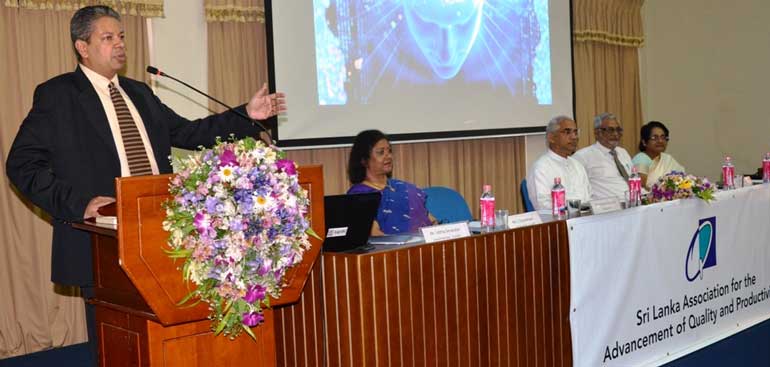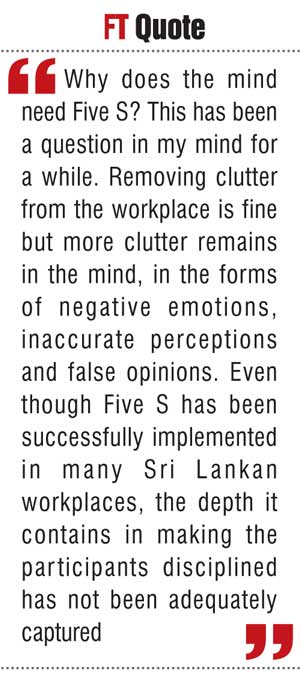Sunday Nov 23, 2025
Sunday Nov 23, 2025
Monday, 16 November 2015 00:00 - - {{hitsCtrl.values.hits}}
 Prof. AjanthaDharmasiri delivering the key note speech at the Annual Five S Conference
Prof. AjanthaDharmasiri delivering the key note speech at the Annual Five S Conference
It was a meaningful occasion when I had to deliver the keynote address at the Annual Five S Conference, organised by the Sri Lanka Association of Quality and Productivity, held recently.
I spoke on the ‘Five S for the Mind’ highlighting the need to focus on mind over matter. Today’s column contains the essence of what I shared.
 Overview
Overview
Better housekeeping, greater orderliness and enhanced productivity are just some of the benefits of the popular approach known as the ‘Five S’ system. It is no stranger to the Sri Lankan workplace. I think it has much more depth and breadth than that.
The ‘Five S’ system originated in Japan, and stands for five Japanese words that start with the letter S: Seiri, Seiton, Seiso, Seiketsu and Shitsuke. An equivalent set of five ‘S’ words in English have likewise been adopted by many, to preserve the Five S acronym in English usage. These are: Sort, Set, Shine, Standardise and Sustain.
The Five S system offers a systematic approach to keeping things in order. It is a visual technique of ensuring proper housekeeping as well. As Hiroyuki Hirano (1995) stated in ‘Five Pillars of the Visual Workplace’, the Five S forms the bedrock for productivity.
Furthermore, Takashi Osada, (1995) highlights in ‘The Fiv5S’s: Five keys to a Total Quality Environment’, it offers a pathway for quality and productivity improvements.
Understanding the mind
As the first stanza of the revered text the Dhammapada states: “Mano pubbaagma dhamma, mano setta manomaya.” This essentially means that the mind is the forerunner for all things. Whilst its supremacy has always been undisputedly accepted, what is mind has been a perennial question. Philosophers strived to describe it while psychologists struggled to define it.
As one relatively simpler definition says, the mind is the human consciousness that originates in the brain and is manifested especially in thought, perception, emotion, will, memory and imagination.
Psychologists such as Sigmund Freud and William James have developed influential theories about the nature of the human mind. In the late 20th and early 21st centuries the field of cognitive science emerged and developed many varied approaches to the description of the mind and its related phenomena.
In Sigmund Freud’s psychoanalytic theory of personality, the conscious mind consists of everything inside of our awareness. This is the aspect of our mental processing that we can think and talk about in a rational way. The conscious mind includes such things as sensations, perceptions, memories, feelings and fantasies inside of our current awareness.
Why and how
Why does the mind need Five S? This has been a question in my mind for a while. Removing clutter from the workplace is fine but more clutter remains in the mind, in the forms of negative emotions, inaccurate perceptions and false opinions. Even though Five S has been successfully implemented in many Sri Lankan workplaces, the depth it contains in making the participants disciplined has not been adequately captured. Let’s discuss each S in detail.
Seiri (Sort)
This is the starting point. Typical workplace activities include going through all tools, materials and so forth in the plant and work area. Keeping only essential items and eliminating what is not required, prioritising things per requirements and keeping them in easily-accessible places are other key actions. Everything else is stored or discarded.
It refers to the act of throwing away all unwanted, unnecessary and unrelated materials in the workplace. People involved in Seiri must not feel sorry about having to throw away things. The idea is to ensure that everything left in the workplace is related to work. Even the number of necessary items in the workplace must be kept to their absolute minimum. Because of seiri, the simplification of tasks, the effective use of space and the careful purchase of items take place.
The way I think, the deep relevance of Seiri to the mind is purposefulness. In order to ensure clarity over clutter with “right seeing” (Samma Dhitti), one needs to identify positive thoughts, constructive emotions and unbiased perceptions with a clear purpose in mind. This is much more difficult than sorting things in a workplace.
Seiton (Set)
This typically means arranging the workplace, equipment, parts, and instructions in such a way that the work flows free of waste through value-added tasks with a division of labour necessary to meet demand. It follows the practice of “everything has a proper place”. It is all about efficiency.
When applied correctly with flow established this step eliminates the majority of the non-value-added time and allows the rest of the zero defect philosophy to be enabled. In essence, until there is an orderly flow, you cannot avoid flaws in tackling problems and the notion of zero defects is not possible at all.
As I observe, the deep relevance of Seiton to the mind is prioritising. It requires focusing on value creation. Connecting thoughts in a logical manner with proper analysis is the need. It in fact helps oneself to focus on tasks linked to targets in the context of overall purpose. What is connected to the purpose has to be a priority. The rest have to be set aside to be done only when time permits.
Seiso (Shine)
This involves cleaning the workspace and all equipment and keeping them organised. In a typical factory, at the end of each shift, clean the work area and be sure everything is restored to its place. This step ensures that the workstation is ready for the next user and that order is sustained.
In fact, Seiso invites us to become our own janitors. As the Japanese advocate, cleaning must be done by everyone in the organisation, from the directors to drivers. Everyone should see the workplace through the eyes of a visitor - always thinking if it is clean enough to make a good impression.
The way I see it, the deep relevance of Seiso to the mind is purity. This is where the spiritual dimension looms large. Pure thoughts devoid of malice, jealously and other negativities are what are required. A shining mind is a spiritual mind empathising with others compassionately.
Seiketsu (Sustain)
This is all about uniformity and consistency. In a typical workplace, uniform procedures need to be ensured throughout an operation to promote inter-changeability.
Seiketsu can also be viewed as “conformance to consistent clean-up”. It consists of defining the standards by which people must measure and maintain ‘cleanliness’. Seiketsu encompasses both people and environmental cleanliness. Personal tidiness can be a good starting point.
I think the deep relevance of Seiketsu to the mind is perseverance. So many start-ups might end up halfway through without proper completion. A mind that is geared towards perseverance will ensure continuity of a recommended habit, preferred value or a best practice. One needs determination and dedication in order to sustain noteworthy initiatives.
Shitsuke (Standardise)
This refers to ensuring the disciplined adherence to the previous four Ss. It assists in preventing a possible backsliding to where thing were prior to the implementation of the Five S system.
The key word here is discipline. It denotes practicing the Five S as a way of life. As the Japanese say, the emphasis of Shitsuke is the elimination of bad habits and the constant practise of good ones. Once true Shitsuke is achieved, people will keep things naturally, without reminders and warnings.
The way I see it, the deep relevance of Shitsuke to the mind is proactiveness. With a proactive mind, purposeful, prioritised, pure actions can be continued with perseverance. In essence, it sums up the overall application of the Five S to the mind.
From Five S to Five Ps
As we saw clearly so far, the Five S for the workplace can be applicable in a deep way as the Five S for the mind. In such an approach, it can even be called Five Ps. They are purposefulness, prioritising, purity, perseverance and proactiveness. Table 1 captures this comparison of Five S for matter and Five P for the mind.
Sri Lankan managers can embrace the above Five Ps and then engage in the Five Ss so that the mind and matter can be both organised in a better way.
The sad thing I have observed in some Sri Lankan workplaces is that the Five S has become an award-winning exercise overly focused on the workplace leaving aside the deeper aspect of the mind. I would argue that the Five S should begin with the mind and then be applied to matter.
Let me revisit the first stanza of the Dhammapada as per the ‘Treasury of Truth’ (www. Buddhanet.net) to conclude.
Mind precedes all knowables,
mind’s their chief, mind-made are they.
If with a corrupted mind
one should either speak or act
dukkha follows caused by that,
as does the wheel the ox’s hoof.
(Prof. Ajantha Dharmasiri can be reached through [email protected] or www.ajanthadharmasiri.info)